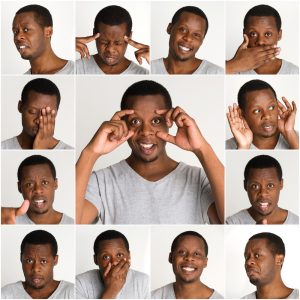Two Perspectives on How Emotions are Made

Dr. Lisa Feldman Barrett, neuroscientist, TED speaker, and author of the book, “How Emotions are Made,” says that we construct our own emotions.
When I first heard this it sounded so preposterous! Emotions feel so innate. When something happens, we don’t sit there trying to figure out how to respond. In fact, we often feel something first, right before we have a good sense of our story around it.
So how did she come to the conclusion that we construct our emotions? As I listened to her book, I realized her views match what I have been telling clients, but from a completely different point of view!
The Neuroscientific Perspective of “How Emotions are Made”
In her book, she explains how we construct our emotions. Our brains, bodies, environment, language, and culture all contribute in various ways.
We predict our reality
Our brain doesn’t have the capacity to respond to every single stimulus. It cannot manage and process every detail from the environment. To save energy, it makes predictions about how we will respond. According to Dr. Barrett, we predict our reality as a much more efficient way of handling our environment.
When our environment doesn’t match what we expect to happen, we experience that dissonance as the emotion “shock.”
We interpret emotions based on context
I have what could some call a “resting bitch face.” In my past, people accused me of being angry or looking at them in an offensive way when that was not my intention.
This is something I so desperately wanted change and, surprisingly, it has! But it isn’t my expression that has changed. It’s people’s overall impression of me, which determines their interpretation of my expression.
Even research shows a face labeled as “resting bitch face” is a structurally neutral face. People who see more negativity in a face conclude that from a combination of context and their own assumptions.
Different people react differently to what we say. I can accuse one friend of being a slacker, and he will laugh (because it’s a private joke between us). But another friend who has a tendency to get defensive would never take that as a joke.
 Another great example of this can be seen when texting. A friend of mine once sent me a fist emoji and I was so confused! Was he suddenly proposing to punch me in the face? I asked him what he meant, and he explained it was a fist bump.
Another great example of this can be seen when texting. A friend of mine once sent me a fist emoji and I was so confused! Was he suddenly proposing to punch me in the face? I asked him what he meant, and he explained it was a fist bump.
He wasn’t threatening me, he was cheering me on. Because fist bumps aren’t part of what I typically encounter, it isn’t how my brain interpreted it. Now that I’m familiar with the fist bump emoji, I now know how to interpret it when he sends it.
Emotions are culturally dependent
As many immigrants know, we often aren’t aware of cultural emotional norms until we live in other countries.
For example, the United States values happy, friendly people. (America is unusual in that we expect people to be happy and smiling so much.) In a country like Russia, people who smile too much aren’t to be trusted. So when McDonald’s opened in Russia, they couldn’t bring their American-style friendly customer service with them. Russian people would not have trusted the employees or the service.
According to the World Happiness Report, Finns are the happiest people in the world. But the Finns would disagree! Unlike Americans, they don’t smile a lot and they have a tendency to downplay their happiness. If you were to ask them, they rank high on life satisfaction but not happiness.
Osaka is known to be the funniest city in Japan. Yet, when humor researcher Peter McGraw and journalist Joel Warner went there, they couldn’t find any laughter. They went to the Japanese Humor and Laughter Society and no one laughed! Humor in Osaka is highly compartmentalized and only found in TV and comedy clubs.
Emotions are concepts formed by our language
When we are a baby, our caregivers help us form concepts that allow us to share our reality with others. Languages develop by categorizing ideas into specific concepts.
Say the word “pizza” to a person in the United States. The single word creates a mental image of the sight and taste of dough, sauce, cheese, and our favorite (or not so favorite) toppings. But to someone from rural China who hasn’t experienced Western culture, the concept of pizza needs to be described in detail to get the point across.
When we examine other languages, we find that emotions are concepts as well.

Did you know the Tahitians do not have the word “sad” or “grief” in their vocabulary? With the loss a loved one, they feel the kind of fatigue they have with the flu, troubled, or unenthusiastic. Because grief and sadness are innate in our culture, it is hard to imagine for us to conceive of how Tahitians feel in response to loss. Do they not feel the heartache that comes with our version of loss?
And yet a Tahitian might be equally confused about our concept of sadness. If it was a common feeling for them, they would have constructed or even borrowed a word from another language to convey the feeling. But they haven’t.
Our emotions are concepts completely developed and defined by our language.
Our emotional responses can change
Because the cultural norms for how we respond emotionally are unique to each culture, it is harder for adults to fit in in foreign countries. But some people are good at picking up on the emotional responses of the locals. They adjust better to fit into their new environment.
In the same way some people adjust to new cultures, our emotional responses can change. Halperin and his colleagues at the New School of Psychology in Israel used cognitive reappraisal to teach Israelis to view Palestinians more objectively. In two separate experiments, the Israelis’ attitudes toward Palestinians changed. They chose more peaceful solutions to resolve the ongoing Palestinian-Israeli conflict. This effect endured when they tested subjects five months later.
Different Approach, Same Conclusions
Interestingly, Dr. Barret’s research and arguments for constructed emotions align with what I have found in working with clients. Below are the conclusions I’ve drawn that integrate epigenetics with what we find from working with clients using the Body Code.
We display emotional tendencies that we are born with
 Each person’s response to their environment depends on both their past experiences and their inherited epigenetic experiences.
Each person’s response to their environment depends on both their past experiences and their inherited epigenetic experiences.
Epigenetic experiences passed down through generations affect how we respond emotionally. These experiences make us predisposed to responding in a certain way that makes up our personality. This is what leads to racial stereotypes amongst ethnic groups. If you compare people of the same race from very different backgrounds, the stereotypes no longer apply. For example, an African American who is a descendant of slavery may react very differently to a White person than one whose ancestors came here more recently. Everyone’s epigenetic history plays a role in whether we will feel safe with people whose ancestry we don’t share!
When people release trapped emotions, belief systems, and inherited past, they get a new slate. Clients feel less charged around situations that have upset them. They can then think of more constructive ways of handling their situation.
We attract what we vibrate
The law of attraction states that we attract what we vibrate.
 Every stimulus, whether sound, light, touch, or emotion, vibrates at specific frequencies that profoundly affect us. For example, music can make us tense, enthusiastic, powerful, happy or melancholy. Our emotions depend not only on the vibrational signature of the music but how our nervous systems receive it. Our responses to it are based on our past and our inherited past experiences with similar sounds. Lighting and touch also produce vastly different responses depending on the stimulus and our own internal states.
Every stimulus, whether sound, light, touch, or emotion, vibrates at specific frequencies that profoundly affect us. For example, music can make us tense, enthusiastic, powerful, happy or melancholy. Our emotions depend not only on the vibrational signature of the music but how our nervous systems receive it. Our responses to it are based on our past and our inherited past experiences with similar sounds. Lighting and touch also produce vastly different responses depending on the stimulus and our own internal states.
When we are sad, we don’t choose a stimulus that makes us happy. If we are happy, we aren’t going to be that interested in a depressing movie. We choose stimuli, situations, and even friends that align with our emotional states.
In the same way, we become more attuned to situations or experiences in our reality that align with our emotional states. If we feel sad, we home in on what makes us sad. If we feel frustrated, we get more easily frustrated by traffic, by spam calls, or our pet peeves.
Energy medicine explains this from a vibrational perspective. Neuroscience says that we predict our reality to save our cognitive resources. These two divergent explanations come to the same conclusion.
Our environment shapes our response
Hypnotherapists know how to induce a trance state where we are more susceptible to suggestion. They also know that we regularly go into a state where we are more susceptible to environmental influences. For example, listening to a good story or watching a TV show takes us into a more suggestible state. Effective advertising convinces us not by logic or reason, but by using more subconscious forces. They imply by using good looking models that we would be a better person if we used their products. Subconscious influences from environmental forces like these are called post-hypnotic suggestions.
A great example is when TV producers include laugh tracks in comedy shows to help us determine what is funny. Or at a live comedy show, other people laughing causes us to have a better time. Our laughter can depend on a variety of factors that could have nothing to do with how funny the comedian is!
 I’m often releasing negative post-hypnotic suggestions that clients get from their environment. A common environmental post-hypnotic suggestion for women is that women don’t make good leaders. For men, it might be the idea that men must “man up” and not show emotion, express weakness, or ask for help.
I’m often releasing negative post-hypnotic suggestions that clients get from their environment. A common environmental post-hypnotic suggestion for women is that women don’t make good leaders. For men, it might be the idea that men must “man up” and not show emotion, express weakness, or ask for help.
While these ideas may not be explicitly taught to us, we get them from how our society responds to each gender. Immersed in our society as we grow up, we become unconsciously indoctrinated in these beliefs. Environmental post-hypnotic suggestions also contribute to why it is taking women and minorities so long to be treated as equals to white men.
Post-hypnotic suggestions are powerful undercurrents that shape how we feel about ourselves and each other.
Our emotional responses can change
We often think we are thinking objectively. But as we get older and develop more experiences and meet more diverse people, we start to see that ours is not the only way of thinking. We then become more open to the idea that some thoughts are opinions, not fact.
When we release the epigenetic and early life negative responses to our environment, we wash away any negative reactions we may have to a person or an event. By working with just one member of a couple, some client’s relationships have been revitalized after being on the brink of divorce! Others have ended by the client’s own choice.
When our responses change, our reality changes as well.
We can construct our own emotions!
Dr. Barrett asserts that we construct our own emotions and our own reality. I would add a more nuanced perspective. While I don’t believe our emotions are innate, I believe our brain co-constructs our emotions along with the stored responses in our brain that come from our past and our epigenetic past. Our emotions get co-constructed along with our environment, whether it is the people around us or even the air quality! And finally our brain co-constructs emotions along with our internal states, which could be determined by what we ate that day, the amount of sleep we’ve had, whether there is a pathogen or toxin lurking in our system, the microbiome in our gut, or any other bodily discomfort we may be feeling.
And the co-construction of our emotions happens subconsciously… that is until now.
Dr. Barrett and I both agree that now that we have a better understanding of where our emotions come from, we have a responsibility to develop healthier emotional responses. With conscious awareness of how we co-construct our emotions, we can take back the reins of our emotional responses so that we can construct our own emotions.
We can look to the gentle spirit of Buddhist monks who spend countless hours in deep meditation to envision what is possible when we construct our own emotions. Our modern-day society doesn’t allow us to spend countless hours on our meditation cushions. But we should still meditate: even a small amount can make a difference.
How to construct our emotions: 2 different perspectives with the same conclusions

So how do we construct our emotions? By changing our internal states. We need to become aware of our environment and how it affects us, and then adjust our environment to create the mood we want. It is important to keep ourselves healthy and happy with good habits, and address problems that arise. We need to give our bodies what they need to rest, renew, and detox. And finally, we must release the traumas, belief systems, and more from our past and inherited past that keep our brains stuck in unhealthy thought patterns and emotional responses.
Are you ready to be healthier and happier? Releasing old emotional responses and beliefs from the past will change your future. Contact me here to schedule your complimentary consultation!



